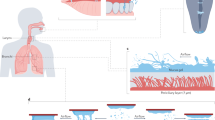Abstract
By studying the behavior of various tracer species in the lungs, one can assess many important characteristics which distinguish normal and abnormal function. Quantitative evaluation of function depends on the use of an appropriate model in conjunction with experimental data. A multi-compartment model is derived from mass balances to describe dynamic as well as (breath-averaged) steady-state transport processes between the environment and pulmonary capillary blood. The breathing cycle is divided into three time periods (inspiration, expiration, and pause) so that the model equations are discrete in time. No other model of tracer species transport in the lungs deals simultaneously with species dynamics, variable breathing pattern, distribution inhomogeneities, and non-equilibrium between alveolar gas and capillary blood. Models currently in the literature are shown to be special cases of the model presented here.
Similar content being viewed by others
Literature
Bouhuys, A. 1977.The Physiology of Breathing. New York: Grune & Stratton.
Cander, L. 1959. “Solubility of Inert Gases in Human Lung Tissue.”J. Appl. Physiol.,14, 538–540.
Cander, L. and R. Forster. 1959. “Determination of Pulmonary Parenchymal Tissue Volume and Pulmonary Capillary Blood Flow in Man.”J. Appl. Physiol.,14, 541–551.
Farhi, L. E. 1967. “Elimination of Inert Gas by the Lungs.”Resp. Physiol.,3, 1–11.
Gee, M. H. 1972. TheIn Vivo Volume of the Pulmonary Fluid Compartments in Dogs and the Relationship Between These Volumes and the Hemodynamics of the Pulmonary Circulation. Ph.D. Thesis, University of Colorado, Boulder.
Glauser, F. L., A. Wilson, M. Hoshiko, M. Watanabe and J. Davis. 1974. “Pulmonary Parenchymal Tissue Changes in Pulmonary Edema.”J. Appl. Physiol.,36, 648–652.
Hlastala, M. P. and H. T. Robertson. 1978. “Inert Gas Elimination Characteristics of the Normal and Abnormal Lung.”J. Appl. Physiol. 44, 258–266.
Reid, M. H. and H. B. Hechtman. 1974. “A Multicompartment Analysis of the Lung.”Med. Biol. Engng,12, 405–413.
Saidel, G. M., T. C. Militano and E. H. Chester 1971. “Pulmonary Gas Transport Characterization by a Dynamic Model.”Resp. Physiol.,12, 305–328.
—, J. Saniie and E. H. Chester. 1978. “Modeling and Moments of Multibreath Lung Washout.”Ann. Biomed. Engng,6, 126–237.
Schrimshire, D. and P. Tomlin. 1973. “Gas Exchange During Initial Stages of N2O Uptake and Elimination in a Lung Model.”J. Appl. Physiol.,34, 775–789.
Stout, R., H. Wessel and M. Paul. 1975. “Pulmonary Blood Flow Determined by Continuous Analysis of Pulmonary N2O Exchange.”J. Appl. Physiol.,38, 913–918.
Wagner, P., H. Saltzman and J. B. West. 1974. “Measurement of Continuous Distributions of Ventilation-Perfusion Ratio: Theory.”J. Appl. Physiol.,36, 588–599.
Zwart, A., R. C. Seagrave and A. Van Dieren, 1976. “Ventilation-Perfusion Ratio Obtained by a Noninvasive Frequency Response Technique.”J. Appl. Physiol.,41, 419–424.
Author information
Authors and Affiliations
Rights and permissions
About this article
Cite this article
Saidel, G.M., Burma, G.M. Multibreath tracer species dynamics in the lung. Bltn Mathcal Biology 43, 1–19 (1981). https://doi.org/10.1007/BF02460935
Received:
Revised:
Issue Date:
DOI: https://doi.org/10.1007/BF02460935




